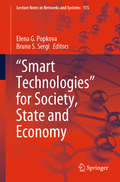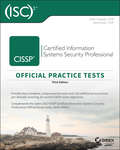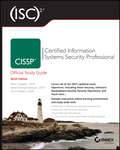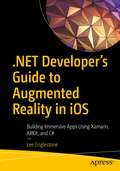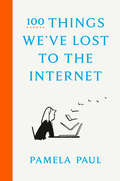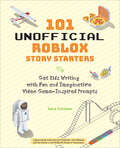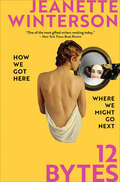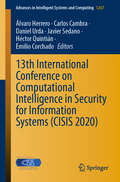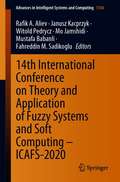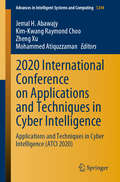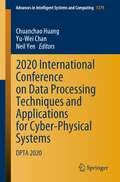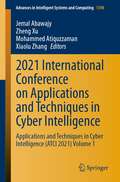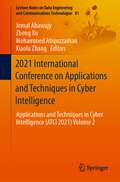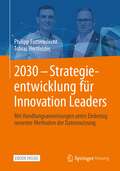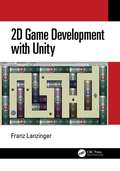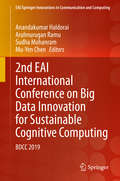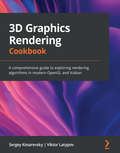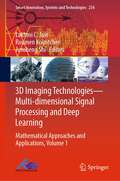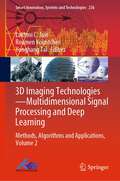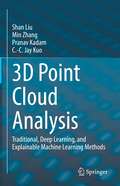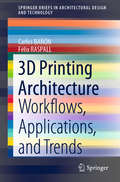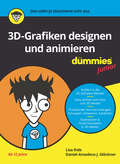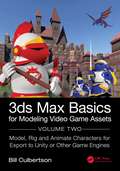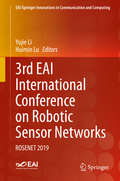- Table View
- List View
"Smart Technologies" for Society, State and Economy (Lecture Notes in Networks and Systems #155)
by Elena G. Popkova Bruno S. SergiThis proceedings book presents a comprehensive view of “smart” technologies and perspectives of their application in various areas of economic activity. The authors of the book combined the results of the cutting-edge research on the topic of “smart” technologies in the digital economy and Industry 4.0 and developed a unified scientific concept. The current experience has been considered, and the prospects for the application of “smart” technologies in society to promote social advance have been identified. “Smart” technologies in public administration and law, as well as the experience in development of e-government, have been examined. “Smart” technologies in business activity have been studied, and the transition from digital business to business 4.0 has been justified. The book contains the collection of the best works following the results of the 13th International Research-to-Practice Conference “Smart Technologies” for society, state and economy which was run by the Institute of Scientific Communications (ISC) and was held on July 2–3, 2020. The target audience of this book includes researchers investigating fundamental and applied problems of development of “smart” technologies, as well as concerned parties outside the academic community, in particular, representatives of the digital society, high-tech business entities and officials regulating the digital economy and Industry 4.0.
(ISC)2 CISSP Certified Information Systems Security Professional Official Practice Tests
by David Seidl Mike ChappleFull-length practice tests covering all CISSP domains for the ultimate exam prep The (ISC)2 CISSP Official Practice Tests is a major resource for (ISC)2 Certified Information Systems Security Professional (CISSP) candidates, providing 1300 unique practice questions. The first part of the book provides 100 questions per domain. You also have access to four unique 125-question practice exams to help you master the material. As the only official practice tests endorsed by (ISC)2, this book gives you the advantage of full and complete preparation. These practice tests align with the 2021 version of the exam to ensure up-to-date preparation, and are designed to cover what you will see on exam day. Coverage includes: Security and Risk Management, Asset Security, Security Architecture and Engineering, Communication and Network Security, Identity and Access Management (IAM), Security Assessment and Testing, Security Operations, and Software Development Security. The CISSP credential signifies a body of knowledge and a set of guaranteed skills that put you in demand in the marketplace. This book is your ticket to achieving this prestigious certification, by helping you test what you know against what you need to know. Test your knowledge of the 2021 exam domains Identify areas in need of further study Gauge your progress throughout your exam preparation Practice test taking with Sybex’s online test environment containing the questions from the book, which is supported by Wiley's support agents who are available 24x7 via email or live chat to assist with access and login questions The CISSP exam is refreshed every few years to ensure that candidates are up-to-date on the latest security topics and trends. Currently-aligned preparation resources are critical, and periodic practice tests are one of the best ways to truly measure your level of understanding.
(ISC)2 CISSP Certified Information Systems Security Professional Official Study Guide
by Darril Gibson Mike Chapple James Michael StewartCISSP Study Guide - fully updated for the 2021 CISSP Body of Knowledge (ISC)2 Certified Information Systems Security Professional (CISSP) Official Study Guide, 9th Edition has been completely updated based on the latest 2021 CISSP Exam Outline. This bestselling Sybex Study Guide covers 100% of the exam objectives. You'll prepare for the exam smarter and faster with Sybex thanks to expert content, knowledge from our real-world experience, advice on mastering this adaptive exam, access to the Sybex online interactive learning environment, and much more. Reinforce what you've learned with key topic exam essentials and chapter review questions. The three co-authors of this book bring decades of experience as cybersecurity practitioners and educators, integrating real-world expertise with the practical knowledge you'll need to successfully pass the CISSP exam. Combined, they've taught cybersecurity concepts to millions of students through their books, video courses, and live training programs. Along with the book, you also get access to Sybex's superior online interactive learning environment that includes: Over 900 new and improved practice test questions with complete answer explanations. This includes all of the questions from the book plus four additional online-only practice exams, each with 125 unique questions. You can use the online-only practice exams as full exam simulations. Our questions will help you identify where you need to study more. Get more than 90 percent of the answers correct, and you're ready to take the certification exam. More than 700 Electronic Flashcards to reinforce your learning and give you last-minute test prep before the exam A searchable glossary in PDF to give you instant access to the key terms you need to know for the exam New for the 9th edition: Audio Review. Author Mike Chapple reads the Exam Essentials for each chapter providing you with 2 hours and 50 minutes of new audio review for yet another way to reinforce your knowledge as you prepare. Coverage of all of the exam topics in the book means you'll be ready for: Security and Risk Management Asset Security Security Architecture and Engineering Communication and Network Security Identity and Access Management (IAM) Security Assessment and Testing Security Operations Software Development Security
.NET Developer's Guide to Augmented Reality in iOS: Building Immersive Apps Using Xamarin, ARKit, and C#
by Lee EnglestoneAttention .NET developers, here is your starting point for learning how to create and publish augmented reality (AR) apps for iOS devices. This book introduces and explores iOS augmented reality mobile app development specifically for .NET developers. The continued adoption and popularity of Xamarin, a tool that allows cross-platform mobile application development, opens up many app publishing opportunities to .NET developers that were never before possible, including AR development. You will use Xamarin to target Apple’s augmented reality framework, ARKit, to develop augmented reality apps in the language you prefer—C#. Begin your journey with a foundational introduction to augmented reality, ARKit, Xamarin, and .NET. You will learn how this remarkable collaboration of technologies can produce fantastic experiences, many of them never before tried by .NET developers. From there you will dive into the fundamentals and then explore various topics and AR features. Throughout your learning, proof of concepts will be demonstrated to reinforce learning. After reading this book you will have the fundamentals you need, as well as an understanding of the overarching concepts that combine them. You will come away with an understanding of the wide range of augmented reality features available for developers, including the newest features included in the latest versions of ARKit. What You Will Learn Create rich commercial and personal augmented reality mobile appsExplore the latest capabilities of ARKitExtend and customize chapter examples for building your own amazing appsGraduate from traditional 2D UI app interfaces to immersive 3D AR interfacesWho This Book Is For Developers who want to learn how to use .NET and C# to create augmented reality apps for iOS devices. It is recommended that developers have some Xamarin experience and are aware of the cross-platform options available to .NET. A paid Apple developer account is not needed to experiment with the AR code samples on your devices.
100 Things We've Lost to the Internet
by Pamela PaulThe acclaimed editor of The New York Times Book Review takes readers on a nostalgic tour of the pre-Internet age, offering powerful insights into both the profound and the seemingly trivial things we've lost.Remember all those ingrained habits, cherished ideas, beloved objects, and stubborn preferences from the pre-Internet age? They&’re gone.To some of those things we can say good riddance. But many we miss terribly. Whatever our emotional response to this departed realm, we are faced with the fact that nearly every aspect of modern life now takes place in filtered, isolated corners of cyberspace—a space that has slowly subsumed our physical habitats, replacing or transforming the office, our local library, a favorite bar, the movie theater, and the coffee shop where people met one another&’s gaze from across the room. Even as we&’ve gained the ability to gather without leaving our house, many of the fundamentally human experiences that have sustained us have disappeared.In one hundred glimpses of that pre-Internet world, Pamela Paul, editor of The New York Times Book Review, presents a captivating record, enlivened with illustrations, of the world before cyberspace—from voicemails to blind dates to punctuation to civility. There are the small losses: postcards, the blessings of an adolescence largely spared of documentation, the Rolodex, and the genuine surprises at high school reunions. But there are larger repercussions, too: weaker memories, the inability to entertain oneself, and the utter demolition of privacy.100 Things We&’ve Lost to the Internet is at once an evocative swan song for a disappearing era and, perhaps, a guide to reclaiming just a little bit more of the world IRL.
101 Unofficial Roblox Story Starters: Get Kids Writing with Fun and Imaginative Video Game-Inspired Prompts
by Sara ColemanWrite imaginative and awesome stories with prompts inspired by Roblox!Elementary-age kids will learn just how fun writing can be with this collection of 101 story starters, all based on their favorite video game. This book will provide prompts paired with blank lines for journaling, so everything needed to jumpstart the writing process is all in one place. Plus, with a friendly introduction on how to use the book and begin story writing, kids&’ creativity will be flowing in no time. Kids will enjoy hours of screenless activity time thanks to the sometimes hilarious sometimes fascinating story prompts based on the most popular Roblox games! Plus, they'll be able to keep up their writing skills and prevent summer learning loss in a way that's fun, funny, and creative.
12 Bytes: How Ai Will Change The Way We Live And Love
by Jeanette Winterson&“Witty [and] provocative&” essays on how AI might change us by the New York Times–bestselling author of Why Be Happy When You Can Be Normal? (Kirkus Reviews). When we create non-biological life-forms, will we do so in our image? Or will we accept the once-in-a-species opportunity to remake ourselves in their image? What do love, caring, sex, and attachment look like when humans form connections with non-human helpers, teachers, sex-workers, and companions? And what will happen to our deep-rooted assumptions about gender? Will the physical body that is our home soon be enhanced by biological and neural implants, keeping us fitter, younger, and connected? Is it time to join Elon Musk and leave Planet Earth? In twelve eye-opening, mind-expanding, funny, and provocative essays on the implications of artificial intelligence that look to history, religion, myth, literature, politics, and computer science to help us understand, Jeanette Winterson tackles AI&’s most fascinating talking points, from the algorithms that data-dossier your whole life to the weirdness of backing up your brain. &“Thought-provoking and necessary—and sometimes very funny.&” —The Guardian &“Fascinating. . . . Winterson makes granular tech know-how remarkably accessible.&” —Publishers Weekly
125 Problems in Text Algorithms: with Solutions
by Maxime Crochemore Thierry Lecroq Wojciech RytterString matching is one of the oldest algorithmic techniques, yet still one of the most pervasive in computer science. The past 20 years have seen technological leaps in applications as diverse as information retrieval and compression. This copiously illustrated collection of puzzles and exercises in key areas of text algorithms and combinatorics on words offers graduate students and researchers a pleasant and direct way to learn and practice with advanced concepts. The problems are drawn from a large range of scientific publications, both classic and new. Building up from the basics, the book goes on to showcase problems in combinatorics on words (including Fibonacci or Thue-Morse words), pattern matching (including Knuth-Morris-Pratt and Boyer-Moore like algorithms), efficient text data structures (including suffix trees and suffix arrays), regularities in words (including periods and runs) and text compression (including Huffman, Lempel-Ziv and Burrows-Wheeler based methods).
13th International Conference on Computational Intelligence in Security for Information Systems (Advances in Intelligent Systems and Computing #1267)
by Álvaro Herrero Javier Sedano Héctor Quintián Emilio Corchado Daniel Urda Carlos CambraThis book contains accepted papers presented at CISIS 2020 held in the beautiful and historic city of Burgos (Spain), in September 2020.The aim of the CISIS 2020 conference is to offer a meeting opportunity for academic and industry-related researchers belonging to the various, vast communities of computational intelligence, information security, and data mining. The need for intelligent, flexible behaviour by large, complex systems, especially in mission-critical domains, is intended to be the catalyst and the aggregation stimulus for the overall event.After a thorough peer-review process, the CISIS 2020 International Program Committee selected 43 papers which are published in these conference proceedings achieving an acceptance rate of 28%. Due to the COVID-19 outbreak, the CISIS 2020 edition was blended, combining on-site and on-line participation. In this relevant edition, a special emphasis was put on the organization of five special sessions related to relevant topics as Fake News Detection and Prevention, Mathematical Methods and Models in Cybersecurity, Measurements for a Dynamic Cyber-Risk Assessment, Cybersecurity in a Hybrid Quantum World, Anomaly/Intrusion Detection, and From the least to the least: cryptographic and data analytics solutions to fulfil least minimum privilege and endorse least minimum effort in information systems.The selection of papers was extremely rigorous in order to maintain the high quality of the conference and we would like to thank the members of the Program Committees for their hard work in the reviewing process. This is a crucial process to the creation of a high standard conference, and the CISIS conference would not exist without their help.
14th International Conference on Theory and Application of Fuzzy Systems and Soft Computing – ICAFS-2020 (Advances in Intelligent Systems and Computing #1306)
by Witold Pedrycz Janusz Kacprzyk Mo Jamshidi Rafik A. Aliev Fahreddin M. Sadikoglu Mustafa BabanliThis book presents the proceedings of the 14th International Conference on Applications of Fuzzy Systems, Soft Computing, and Artificial Intelligence Tools, ICAFS-2020, held in Budva, Montenegro, on August 27–28, 2020. It includes contributions from diverse areas of fuzzy systems, soft computing, AI tools such as uncertain computation, decision making under imperfect information, deep learning and others. The topics of the papers include theory and application of soft computing, neuro-fuzzy technology, intelligent control, deep learning–machine learning, fuzzy logic in data analytics, evolutionary computing, fuzzy logic and artificial intelligence in engineering, social sciences, business, economics, material sciences and others.
2020 International Conference on Applications and Techniques in Cyber Intelligence: Applications and Techniques in Cyber Intelligence (ATCI 2020) (Advances in Intelligent Systems and Computing #1244)
by Jemal H. Abawajy Kim-Kwang Raymond Choo Mohammed Atiquzzaman Zheng XuThis book presents innovative ideas, cutting-edge findings, and novel techniques, methods, and applications in a broad range of cybersecurity and cyberthreat intelligence areas. As our society becomes smarter, there is a corresponding need to secure our cyberfuture. The book describes approaches and findings that are of interest to business professionals and governments seeking to secure our data and underpin infrastructures, as well as to individual users.
2020 International Conference on Data Processing Techniques and Applications for Cyber-Physical Systems: DPTA 2020 (Advances in Intelligent Systems and Computing #1379)
by Neil Yen Chuanchao Huang Yu-Wei ChanThis book covers cutting-edge and advanced research on data processing techniques and applications for cyber-physical systems, gathering the proceedings of the International Conference on Data Processing Techniques and Applications for Cyber-Physical Systems (DPTA 2020), held in Laibin City, Guangxi Province, China, on December 11–12, 2020. It examines a wide range of topics, including distributed processing for sensor data in CPS networks; approximate reasoning and pattern recognition for CPS networks; data platforms for efficient integration with CPS networks; machine learning algorithms for CPS networks; and data security and privacy in CPS networks. Outlining promising future research directions, the book offers a valuable resource for students, researchers, and professionals alike, while also providing a useful reference guide for newcomers to the field.
2021 International Conference on Applications and Techniques in Cyber Intelligence: Applications and Techniques in Cyber Intelligence (ATCI 2021) Volume 1 (Advances in Intelligent Systems and Computing #1398)
by Xiaolu Zhang Jemal Abawajy Mohammed Atiquzzaman Zheng XuThis book presents innovative ideas, cutting-edge findings, and novel techniques, methods, and applications in a broad range of cybersecurity and cyberthreat intelligence areas. As our society becomes smarter, there is a corresponding need to secure our cyberfuture. The book describes approaches and findings that are of interest to business professionals and governments seeking to secure our data and underpin infrastructures, as well as to individual users.
2021 International Conference on Applications and Techniques in Cyber Intelligence: Applications and Techniques in Cyber Intelligence (ATCI 2021) Volume 2 (Lecture Notes on Data Engineering and Communications Technologies #81)
by Xiaolu Zhang Jemal Abawajy Mohammed Atiquzzaman Zheng XuThis book presents innovative ideas, cutting-edge findings, and novel techniques, methods, and applications in a broad range of cybersecurity and cyberthreat intelligence areas. As our society becomes smarter, there is a corresponding need to secure our cyberfuture. The book describes approaches and findings that are of interest to business professionals and governments seeking to secure our data and underpin infrastructures, as well as to individual users. 1. Highlights recent applications and techniques in cyber intelligence2. Includes the proceedings of the 2021 International Conference on Applications and Techniques in Cyber Intelligence (ATCI 2021) 3. Presents a broad range of scientific research on cyber intelligence
2030 - Strategieentwicklung für Innovation Leaders: Mit Handlungsanweisungen unter Einbezug neuester Methoden der Datennutzung
by Tobias Hertfelder Philipp FutterknechtSeit der Relativitätstheorie wissen wir, dass massereiche Objekte durch ihre Gravitation Dinge anziehen. Je größer die Masse desto größer ist auch die Anziehungskraft. Genauso verhält es sich auch in Strategieprojekten. Jeder Projektteilnehmer ist dabei ein massereicher Teilnehmer und hat Auswirkungen auf das Zusammenspiel. Was sich gravierend geändert hat ist der Einfluss der Daten auf diesen Prozess. Wer dies nicht berücksichtigt, wird in Zukunft enorme Einbußen hinnehmen müssen. Da sich durch diese Veränderung ein neues Gleichgewicht einstellt, ändern sich auch die Erfolgsaussichten der angewandten Methoden und Verhaltensweisen. Wie Sie diesen Wandel meistern können und was Sie dazu benötigen erfahren Sie in diesem Buch.
2D Game Development with Unity
by Franz LanzingerThis book teaches beginners and aspiring game developers how to develop 2D games with Unity. Thousands of commercial games have been built with Unity. The reader will learn the complete process of 2D game development, step by step. The theory behind each step is fully explained. This book contains numerous color illustrations and access to all source code and companion videos. Key Features: Fully detailed game projects from scratch. Beginners can do the steps and create games right away. No coding experience is necessary. Numerous examples take a raw beginner toward professional coding proficiency in C# and Unity. Includes a thorough introduction to Unity 2020, including 2D game development, prefabs, cameras, animation, character controllers, lighting, and sound. Includes a step-by-step introduction to Unity 2019.3. Extensive coverage of GIMP, Audacity, and MuseScore for the creation of 2D graphics, sound effects, and music. All required software is free to use for any purpose including commercial applications and games. Franz Lanzinger is the owner and chief game developer of Lanzinger Studio, an independent game development and music studio in Sunnyvale, California. He started his career in game programming in 1982 at Atari Games, Inc., where he designed and programmed the classic arcade game Crystal Castles. In 1989, he joined Tengen, where he was a programmer and designer for Ms. Pac-Man and Toobin' on the NES. He co-founded Bitmasters, where he designed and coded games including Rampart and Championship Pool for the NES and SNES, and NCAA Final Four Basketball for the SNES and Sega Genesis. In 1996, he founded Actual Entertainment, publisher and developer of the Gubble video game series. He has a B.Sc. in mathematics from the University of Notre Dame and attended graduate school in mathematics at the University of California at Berkeley. He is a former world record holder on Centipede and Burgertime. He is a professional author, game developer, accompanist, and piano teacher. He is currently working on remaking the original Gubble game in Unity and Blender.
2nd EAI International Conference on Big Data Innovation for Sustainable Cognitive Computing: BDCC 2019 (EAI/Springer Innovations in Communication and Computing)
by Anandakumar Haldorai Arulmurugan Ramu Sudha Mohanram Mu-Yen ChenThis proceeding features papers discussing big data innovation for sustainable cognitive computing. The papers feature details on cognitive computing and its self-learning systems that use data mining, pattern recognition and natural language processing (NLP) to mirror the way the human brain works. This international conference focuses on cognitive computing technologies, from knowledge representation techniques and natural language processing algorithms to dynamic learning approaches. Topics covered include Data Science for Cognitive Analysis, Real-Time Ubiquitous Data Science, Platform for Privacy Preserving Data Science, and Internet-Based Cognitive Platform. The 2nd EAI International Conference on Big Data Innovation for Sustainable Cognitive Computing (BDCC 2019) took place in Coimbatore, India on December 12-13, 2019.Contains proceedings from 2nd EAI International Conference on Big Data Innovation for Sustainable Cognitive Computing (BDCC 2019), Coimbatore, India, December 12-13, 2019;Features topics ranging from Data Science for Cognitive Analysis to Internet-Based Cognitive Platforms;Includes contributions from researchers, academics, and professionals from around the world.
3D Graphics Rendering Cookbook: A comprehensive guide to exploring rendering algorithms in modern OpenGL and Vulkan
by Viktor Latypov Sergey KosarevskyBuild a 3D rendering engine from scratch while solving problems in a step-by-step way with the help of useful recipesKey FeaturesLearn to integrate modern rendering techniques into a single performant 3D rendering engineLeverage Vulkan to render 3D content, use AZDO in OpenGL applications, and understand modern real-time rendering methodsImplement a physically based rendering pipeline from scratch in Vulkan and OpenGLBook DescriptionOpenGL is a popular cross-language, cross-platform application programming interface (API) used for rendering 2D and 3D graphics, while Vulkan is a low-overhead, cross-platform 3D graphics API that targets high-performance applications. 3D Graphics Rendering Cookbook helps you learn about modern graphics rendering algorithms and techniques using C++ programming along with OpenGL and Vulkan APIs.The book begins by setting up a development environment and takes you through the steps involved in building a 3D rendering engine with the help of basic, yet self-contained, recipes. Each recipe will enable you to incrementally add features to your codebase and show you how to integrate different 3D rendering techniques and algorithms into one large project. You'll also get to grips with core techniques such as physically based rendering, image-based rendering, and CPU/GPU geometry culling, to name a few. As you advance, you'll explore common techniques and solutions that will help you to work with large datasets for 2D and 3D rendering. Finally, you'll discover how to apply optimization techniques to build performant and feature-rich graphics applications.By the end of this 3D rendering book, you'll have gained an improved understanding of best practices used in modern graphics APIs and be able to create fast and versatile 3D rendering frameworks.What you will learnImprove the performance of legacy OpenGL applicationsManage a substantial amount of content in real-time 3D rendering enginesDiscover how to debug and profile graphics applicationsUnderstand how to use the Approaching Zero Driver Overhead (AZDO) philosophy in OpenGLIntegrate various rendering techniques into a single applicationFind out how to develop Vulkan applicationsImplement a physically based rendering pipeline from scratchIntegrate a physics library with your rendering engineWho this book is forThis book is for 3D graphics developers who are familiar with the mathematical fundamentals of 3D rendering and want to gain expertise in writing fast rendering engines with advanced techniques using C++ libraries and APIs. A solid understanding of C++ and basic linear algebra, as well as experience in creating custom 3D applications without using premade rendering engines is required.
3D Imaging Technologies—Multi-dimensional Signal Processing and Deep Learning: Mathematical Approaches and Applications, Volume 1 (Smart Innovation, Systems and Technologies #234)
by Lakhmi C. Jain Roumen Kountchev Junsheng ShiThis book presents high-quality research in the field of 3D imaging technology. The second edition of International Conference on 3D Imaging Technology (3DDIT-MSP&DL) continues the good traditions already established by the first 3DIT conference (IC3DIT2019) to provide a wide scientific forum for researchers, academia and practitioners to exchange newest ideas and recent achievements in all aspects of image processing and analysis, together with their contemporary applications. The conference proceedings are published in 2 volumes. The main topics of the papers comprise famous trends as: 3D image representation, 3D image technology, 3D images and graphics, and computing and 3D information technology. In these proceedings, special attention is paid at the 3D tensor image representation, the 3D content generation technologies, big data analysis, and also deep learning, artificial intelligence, the 3D image analysis and video understanding, the 3D virtual and augmented reality, and many related areas. The first volume contains papers in 3D image processing, transforms and technologies. The second volume is about computing and information technologies, computer images and graphics and related applications. The two volumes of the book cover a wide area of the aspects of the contemporary multidimensional imaging and the related future trends from data acquisition to real-world applications based on various techniques and theoretical approaches.
3D Imaging Technologies—Multidimensional Signal Processing and Deep Learning: Methods, Algorithms and Applications, Volume 2 (Smart Innovation, Systems and Technologies #236)
by Lakhmi C. Jain Roumen Kountchev Yonghang TaiThis book presents high-quality research in the field of 3D imaging technology. The second edition of International Conference on 3D Imaging Technology (3DDIT-MSP&DL) continues the good traditions already established by the first 3DIT conference (IC3DIT2019) to provide a wide scientific forum for researchers, academia and practitioners to exchange newest ideas and recent achievements in all aspects of image processing and analysis, together with their contemporary applications. The conference proceedings are published in 2 volumes. The main topics of the papers comprise famous trends as: 3D image representation, 3D image technology, 3D images and graphics, and computing and 3D information technology. In these proceedings, special attention is paid at the 3D tensor image representation, the 3D content generation technologies, big data analysis, and also deep learning, artificial intelligence, the 3D image analysis and video understanding, the 3D virtual and augmented reality, and many related areas. The first volume contains papers in 3D image processing, transforms and technologies. The second volume is about computing and information technologies, computer images and graphics and related applications. The two volumes of the book cover a wide area of the aspects of the contemporary multidimensional imaging and the related future trends from data acquisition to real-world applications based on various techniques and theoretical approaches.
3D Point Cloud Analysis: Traditional, Deep Learning, and Explainable Machine Learning Methods
by Min Zhang C.-C. Jay Kuo Shan Liu Pranav KadamThis book introduces the point cloud; its applications in industry, and the most frequently used datasets. It mainly focuses on three computer vision tasks -- point cloud classification, segmentation, and registration -- which are fundamental to any point cloud-based system. An overview of traditional point cloud processing methods helps readers build background knowledge quickly, while the deep learning on point clouds methods include comprehensive analysis of the breakthroughs from the past few years. Brand-new explainable machine learning methods for point cloud learning, which are lightweight and easy to train, are then thoroughly introduced. Quantitative and qualitative performance evaluations are provided. The comparison and analysis between the three types of methods are given to help readers have a deeper understanding. With the rich deep learning literature in 2D vision, a natural inclination for 3D vision researchers is to develop deep learning methods for point cloud processing. Deep learning on point clouds has gained popularity since 2017, and the number of conference papers in this area continue to increase. Unlike 2D images, point clouds do not have a specific order, which makes point cloud processing by deep learning quite challenging. In addition, due to the geometric nature of point clouds, traditional methods are still widely used in industry. Therefore, this book aims to make readers familiar with this area by providing comprehensive overview of the traditional methods and the state-of-the-art deep learning methods. A major portion of this book focuses on explainable machine learning as a different approach to deep learning. The explainable machine learning methods offer a series of advantages over traditional methods and deep learning methods. This is a main highlight and novelty of the book. By tackling three research tasks -- 3D object recognition, segmentation, and registration using our methodology -- readers will have a sense of how to solve problems in a different way and can apply the frameworks to other 3D computer vision tasks, thus give them inspiration for their own future research. Numerous experiments, analysis and comparisons on three 3D computer vision tasks (object recognition, segmentation, detection and registration) are provided so that readers can learn how to solve difficult Computer Vision problems.
3D Printing Architecture: Workflows, Applications, and Trends (SpringerBriefs in Architectural Design and Technology)
by Carlos BAÑÓN Félix RASPALLThis book investigates how architectural design advances as a result of the rapid developments in 3D Printing. As this technology become more powerful, faster and cheaper, novel workflows are becoming available and revolutionizing all stages of the design process, from early spatial concepts, to subsequent project development, advanced manufacturing processes, and integration into functional buildings. Based on a literature review and case studies of ten built projects, the book discusses the implications of the ongoing manufacturing revolution for the field of architecture.
3D-Grafiken Designen und animieren für Dummies Junior (Für Dummies)
by Daniel-Amadeus J. Glockner Lisa IhdeIn diesem Buch lernst du Schritt für Schritt, wie du mit der kostenlosen Software Blender 3D-Objekte für Computerspiele, Videos oder für die Produktion im 3D-Drucker erstellst. Du erfährst, wie du aus einem 2D-Bild ein 3D-Modell machst, wie du das Material änderst, aus dem dein Objekt scheinbar hergestellt ist, wie du Oberflächen gestaltest und was es mit der Mesh-Modellierung auf sich hat. Außerdem kannst du deine Objekte animieren oder beispielsweise Explosionen simulieren. Bestens geeignet für Kinder und Jugendliche ab 12 Jahren.
3ds Max Basics for Modeling Video Game Assets: Volume 2: Model, Rig and Animate Characters for Export to Unity or Other Game Engines
by William CulbertsonAs a textbook for learning the fundamentals of modeling, rigging and animating 3D-modeled characters for use in video games, this step-by-step lesson book builds on the reader's modeling skills acquired from reading Volume I. The reader will model characters for the Castle Environment created in Volume I, which will be rigged using the Character Animation Toolkit (CAT) in 3ds Max and animated with game moves. The Skin Modifier is used for associating the meshes to the rigs and the characters are then exported to the Unity game engine and integrated into the Castle Scene with a Third Person Character camera. As the text introduces new modeling skills, it additionally calls on the reader to perform repetitive tasks, reinforcing skills learned in the process. The content is presented as if the reader is in a working video game studio, being responsible for researching asset design and providing the team with placeholder assets and final model assets that are unwrapped and custom textured using both box mapping and the 3ds Max Quick Peel tool. Although the text uses Autodesk 3ds Max for the modeling program, the principles are transferable to other major modeling programs. Key Features: The goal of this book is to teach the fundamentals of 3D modeling video game characters in a simplified, logical progression optimized for learning at a beginner level. Rigging principles (Linking, Inverse Kinematics [IK], Forward Kinematics [FK], Skin Deformation, Weighting Vertices and more) are introduced in a gradual progression to allow maximum comprehension and retention. This series of modeling exercises is the result of having successfully taught over 1000 video game students the fundamentals of 3D modeling. This complete, clearly written and concise text is written for self-paced learning, helping those instructors who might not be fully trained in 3D modeling and those interested in self-teaching. Includes instructions and project files for exporting the finished project environment into the 3D game engine, Unity. A companion site (www.3dsMaxBasics.com) includes working 3ds Max project files for chapters, notes and corrections, a 3ds Max user interface, 3ds Max shortcut keys and more.
3rd EAI International Conference on Robotic Sensor Networks: ROSENET 2019 (EAI/Springer Innovations in Communication and Computing)
by Huimin Lu Yujie LiThis proceedings presents the papers of the 3rd EAI International Conference on Robotic Sensor Networks (ROSENET 2019). The conference explores the integration of networks and robotic technologies, which has become a topic of increasing interest for both researchers and developers from academic fields and industries worldwide. The authors posit that big networks will be the main approach to the next generation of robotic research, The book discusses how the explosive number of network models and increasing computational power of computers significantly extends the number of potential applications for robotic technologies while also bringing new challenges to each network's community. The conference provided a platform for researchers to share up-to-date scientific achievements in this field. The conference took place August 17, 2019, Kitakyushu, Japan.Presents the proceedings of the 3rd EAI International Conference on Robotic Sensor Networks (ROSENET 2019), August 17, 2019, Kitakyushu, JapanFeatures papers on robotic technologies for healthcare, medicine, military and moreIncludes perspectives from a multi-disciplinary selection of global researchers, academics, and professionals
